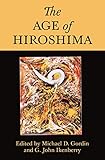The Age of Hiroshima / ed. by Michael D. Gordin, G. John Ikenberry.
Material type: TextPublisher: Princeton, NJ : Princeton University Press, [2020]Copyright date: ©2020Description: 1 online resource (448 p.) : 2 b/w illusContent type:
TextPublisher: Princeton, NJ : Princeton University Press, [2020]Copyright date: ©2020Description: 1 online resource (448 p.) : 2 b/w illusContent type: - 9780691193441
- 9780691195292
- Atomic bomb -- History -- 20th century
- Atomic bomb -- United States -- History
- Nuclear weapons -- Government policy -- 20th century
- Nuclear weapons -- Government policy -- 21st century
- World War, 1939-1945 -- Japan
- World politics -- 20th century
- World politics -- 21st century
- HISTORY / Military / Nuclear Warfare
- 940.54/2521954 23
- D767.25.H6 A34 2020
- online - DeGruyter
- Issued also in print.
| Item type | Current library | Call number | URL | Status | Notes | Barcode | |
|---|---|---|---|---|---|---|---|
 eBook
eBook
|
Biblioteca "Angelicum" Pont. Univ. S.Tommaso d'Aquino Nuvola online | online - DeGruyter (Browse shelf(Opens below)) | Online access | Not for loan (Accesso limitato) | Accesso per gli utenti autorizzati / Access for authorized users | (dgr)9780691195292 |
Frontmatter -- Contents -- Acknowledgments -- 1. Introduction: Hiroshima's Legacies -- Part I. Decisions and Choices -- 2. The Atom Bomb as Policy Maker: FDR and the Road Not Taken -- 3. The Kyoto Misconception: What Truman Knew, and Didn't Know, about Hiroshima -- 4. "When You Have to Deal with a Beast": Race, Ideology, and the Decision to Use the Atomic Bomb -- 5. Racing toward Armageddon? Soviet Views of Strategic Nuclear War, 1955-1972 -- 6. The Evolution of Japanese Politics and Diplomacy under the Long Shadows of Hiroshima and Nagasaki, 1974-1991 -- Part II. Movements and Resistances -- 7. The Bandung Conference and the Origins of Japan's Atoms for Peace Aid Program for Asian Countries -- 8. India in the Early Nuclear Age -- 9. The Unnecessary Option to Go Nuclear: Japan's Nonnuclear Policy in an Era of Uncertainty, 1950s-1960s -- 10. Nuclear Revolution and Hegemonic Hierarchies: How Global Hiroshima Played Out in South America -- 11. Remembering War, Forgetting Hiroshima: "Euroshima" and the West German Anti-Nuclear Weapons Movements in the Cold Wa -- 12. Hiroshima, Nanjing, and Yasukuni: Contending Discourses on the Second World War in Japan -- Part III. Revolutions and Transformations -- 13. The End of the Beginning: China and the Consolidation of the Nuclear Revolution -- 14. Data, Discourse, and Disruption: Radiation Effects and Nuclear Orders -- 15. Nuclear Harms and Global Disarmament -- 16. The Legacy of the Nuclear Taboo in the Twenty-First Century -- 17. History and the Unanswered Questions of the Nuclear Age: Reflections on Assumptions, Uncertainty, and Method in Nuclear Studies -- Notes -- List of Contributors -- Index
restricted access online access with authorization star
http://purl.org/coar/access_right/c_16ec
A multifaceted portrait of the Hiroshima bombing and its many legaciesOn August 6, 1945, in the waning days of World War II, the United States dropped an atomic bomb on the Japanese city of Hiroshima. The city's destruction stands as a powerful symbol of nuclear annihilation, but it has also shaped how we think about war and peace, the past and the present, and science and ethics. The Age of Hiroshima traces these complex legacies, exploring how the meanings of Hiroshima have reverberated across the decades and around the world.Michael D. Gordin and G. John Ikenberry bring together leading scholars from disciplines ranging from international relations and political theory to cultural history and science and technology studies, who together provide new perspectives on Hiroshima as both a historical event and a cultural phenomenon. As an event, Hiroshima emerges in the flow of decisions and hard choices surrounding the bombing and its aftermath. As a phenomenon, it marked a revolution in science, politics, and the human imagination-the end of one age and the dawn of another.The Age of Hiroshima reveals how the bombing of Hiroshima gave rise to new conceptions of our world and its precarious interconnectedness, and how we continue to live in its dangerous shadow today.
Issued also in print.
Mode of access: Internet via World Wide Web.
In English.
Description based on online resource; title from PDF title page (publisher's Web site, viewed 26. Mai 2021)


